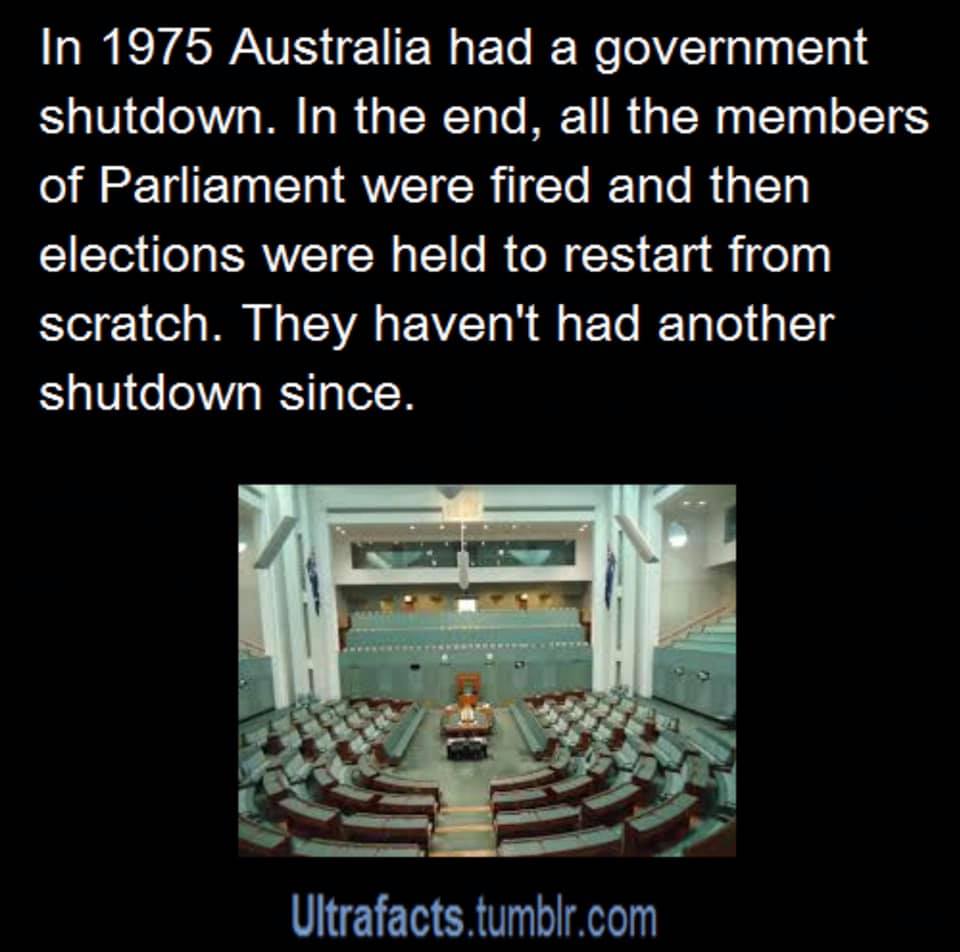On the heels of the longest federal government shutdown in United States history, and on the potential precipice of another shutdown in February 2019, Facebook users started to share a meme about how the country of Australia handled their own government shutdown back in 1975:
The text of the meme stated: "In 1975 Australia had a government shutdown. In the end, all the members of Parliament were fired and then elections were held to restart from scratch. They haven't had another shutdown since."
This meme is largely accurate. Australia's government was effectively shutdown due to a budget impasse in October 1975, the prime minister was dismissed, both houses of Parliament were dissolved, and a new election was held. Since then, Australia has not had another government shutdown.
However, Australia's constitutional crisis in 1975, often referred to as "The Dismissal," was a bit more complicated than portrayed in this meme. Furthermore, the meme is often offered up on social media as a solution to government shutdowns in the United States, but Australia's government doesn't function in the same manner as the U.S. government.
Some of the key differences that enabled "The Dismissal" to occur in Australia is that the country is both a representative democracy and a constitutional monarchy, which means that despite Australia's having elected officials, the head of state in Australia is still the Queen of the United Kingdom and the other Commonwealth realms, as represented by the governor-general). While the Queen rarely exercises her power and is often viewed as a mere figurehead in Australia, the monarch (and in turn the governor-general) is afforded some powers in the country's constitution. During the constitutional crisis of 1975, Governor-General Sir John Kerr used his constitutional authority to dismiss Prime Minister Gough Whitlam.
Australia's constitution also permits a "double dissolution" procedure to resolve deadlocks between the House and Senate:
The Australian Constitution gives almost identical powers to the House of Representatives and the Senate. A bill (proposed law) must be agreed to by both houses in order to become law. The drafters of the Constitution saw the possibility of a deadlock occurring between the two houses, in which there may be disagreement over a bill. Section 57 of the Constitution provides a mechanism to resolve the disagreement, by dissolving both houses of Parliament and calling an election to let the voters decide what the outcome will be. The double dissolution mechanism only relates to a bill that originates in the House of Representatives.
While the viral meme states that members of parliament were "fired" due to the government shutdown, that isn't exactly accurate. Both houses of parliament were dissolved, so all of the seats in the House and Senate went up for election again. The "fired" lawmakers therefore still had a chance to retain their seats by winning them back in a subsequent election.
In 1975, Prime Minister Whitlam and the Australian Labor Party (ALP) held a majority in the House of Representatives, but the Opposition controlled the Senate. When the two parties failed to pass appropriations bills to fund the government, Governor-General Kerr dismissed the prime minister and commissioned Malcom Fraser of the Liberal Party as the caretaker prime minister. Fraser then passed an appropriations bill, and Kerr dissolved Parliament, setting up a double dissolution election to be held the following month.
Here's a summary of what took place from the Australian Broadcast Corporation:
The Dismissal of the Whitlam Government by the Governor-General, on November 11, 1975, still stands as the most dramatic and controversial event in Australia’s political history.
The decision of the Governor-General, Sir John Kerr, to dismiss the Labor Prime Minister, Gough Whitlam, and install the Liberal Opposition Leader, Malcolm Fraser, as caretaker prime minister, on condition that he called an election, was a sensational development that ended a three-week parliamentary stand-off.
The crisis began on October 15, when the Opposition parties announced they would block the government’s Supply Bills in the Senate, as a means of forcing the government to an election. Whitlam refused to call an election and three weeks of parliamentary debate and public campaigning convulsed the political system.
On November 11, Whitlam sought a half-Senate election from the Governor-General. Kerr rejected the advice and dismissed Whitlam. He commissioned Malcolm Fraser as caretaker prime minister. Fraser immediately secured the passage of Supply through the Senate and recommended a double dissolution of the parliament.
The election was held on December 13, 1975. The Fraser-led Coalition won the largest victory in Australia’s federal history.
The Parliament of Australia website provided some additional context to this historic event:
Several weeks later, and after intense negotiations and a third attempt to enact the appropriation bills, the new Governor-General took the extraordinary and unprecedented step of acting at his own initiative to invoke his power under sec. 62 of the Constitution:
There shall be a Federal Executive Council [in practice, the Government] to advise the Governor‑General in the government of the Commonwealth, and the members of the Council shall be chosen and summoned by the Governor‑General and sworn as Executive Councillors, and shall hold office during his pleasure. (emphasis added)
Governor-General Kerr dismissed the Whitlam Government, even though it still enjoyed majority support in the House of Representatives to which, by constitutional convention, it was responsible. To replace it, Kerr appointed a caretaker Liberal Government with Fraser as prime minister. In justifying his decision, the Governor-General argued that, in the Australian system, ‘the confidence of both Houses on supply is necessary to ensure its provision’:
When ... an Upper House possesses the power to reject a money bill including an appropriation bill, and exercises the power by denying supply, the principle that a government which has been denied supply by the Parliament should resign or go to an election must still apply—it is a necessary consequence of Parliamentary control of appropriation and expenditure and of the expectation that the ordinary and necessary services of Government will continue to be provided. (quoted in Odgers’ Australian Senate Practice 2001: 104)
In this position the Governor-General was supported by the Chief Justice, who wrote that:
the Senate has constitutional power to refuse to pass a money bill; it has power to refuse supply to the Government of the day. ... a Prime Minister who cannot ensure supply to the Crown, including funds for carrying on the ordinary services of Government, must either advise a general election (of a kind which the constitutional situation may then allow) or resign. (quoted in Odgers’ Australian Senate Practice 2001: 105)
Not surprisingly, the two houses reacted very differently. The Senate acted almost instantaneously to pass the stalled appropriation bills. The House agreed to a motion expressing its lack of confidence in the newly-designated prime minister and requesting the Speaker to ask the Governor-General to have Whitlam again form a government. But before the Speaker was allowed to deliver this message, the Governor-General declared, at Fraser’s request and by pre-arrangement, a double dissolution of both houses. As Solomon put it:
In the 1975 double dissolution, the Governor-General had to dismiss a Prime Minister (who controlled a majority in the House of Representatives) and appoint another (who lacked the confidence of that House) to find an advisor who was prepared to recommend to him the course he wished to adopt—namely the dissolution of both Houses of Parliament under section 57. (Solomon 1978: 169)
While some Americans may look at Australia's constitutional crisis of 1975 as a "solution" to modern U.S. government shutdowns, "The Dismissal" remains one of the most controversial events in Australia's history:


